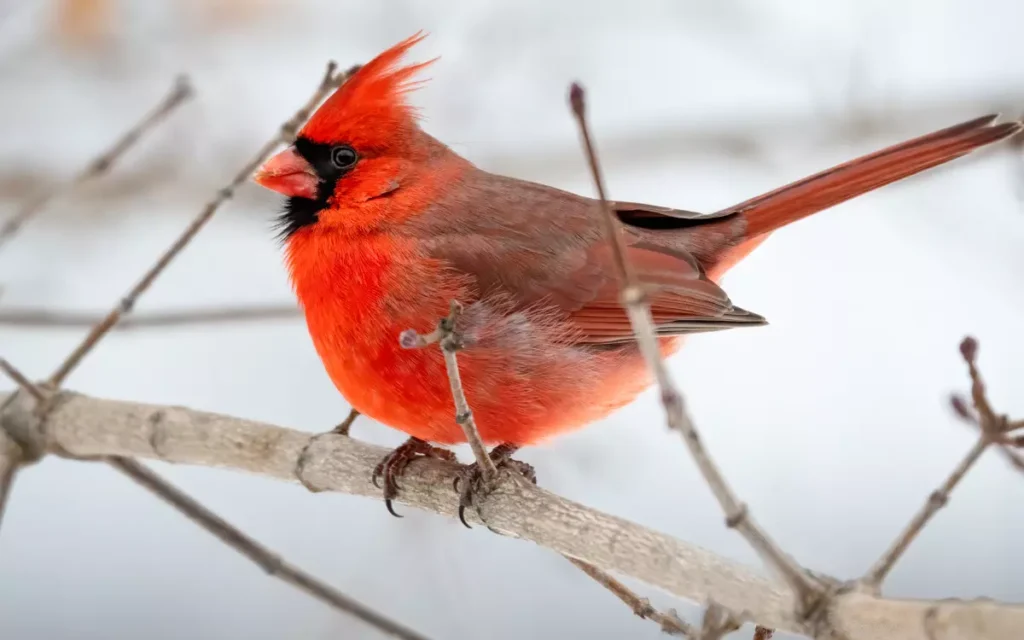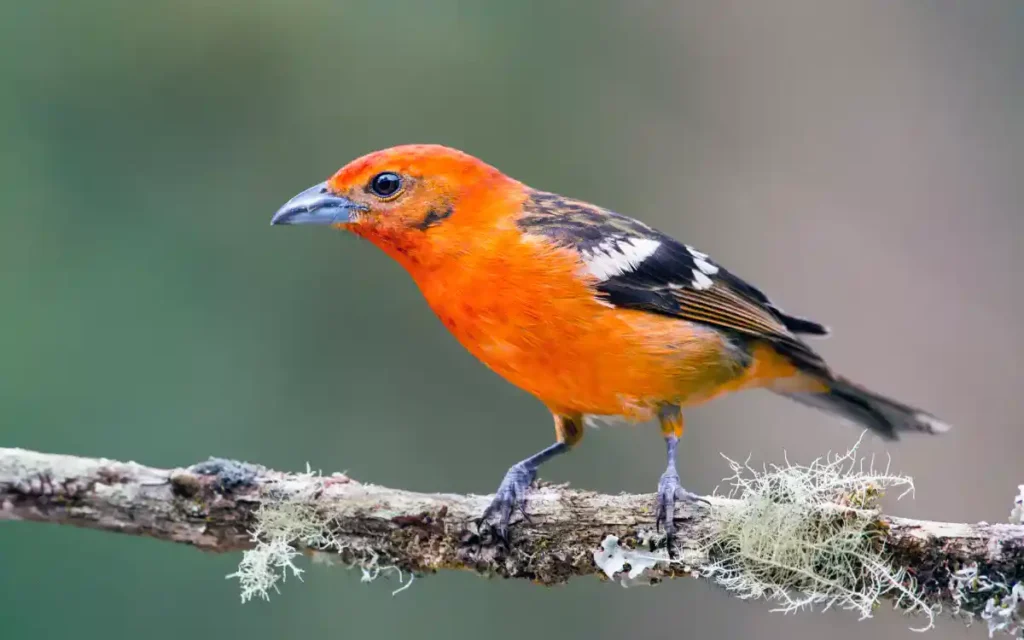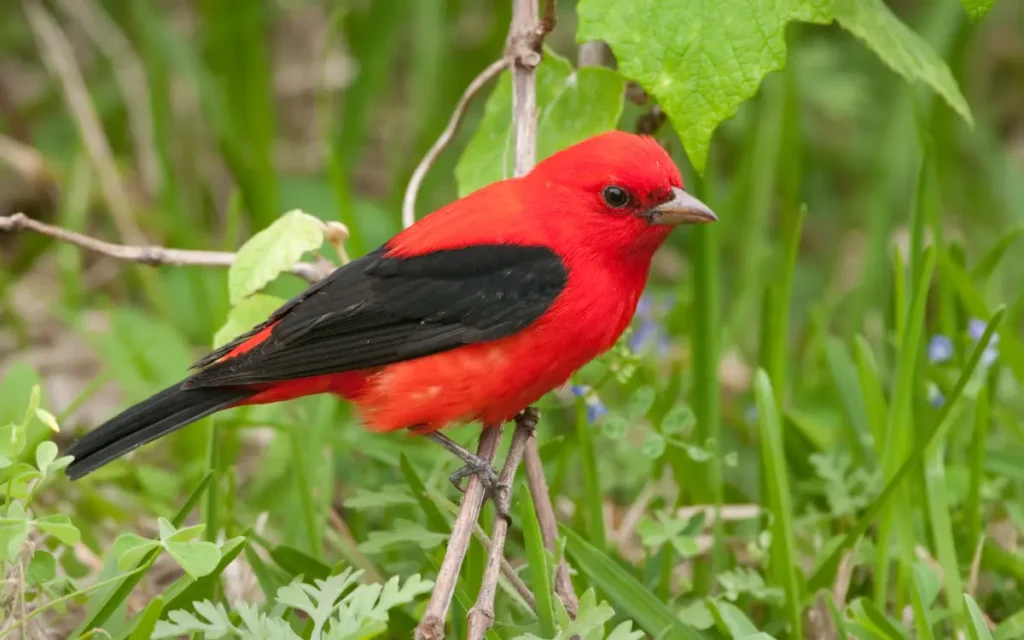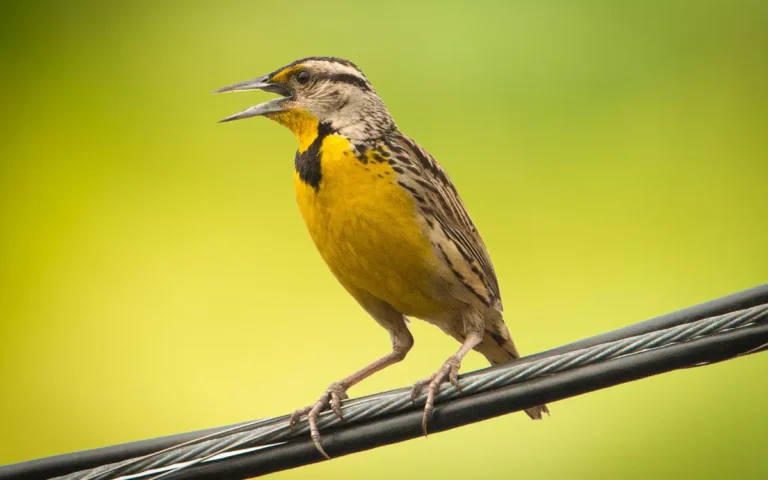15 Red Birds Live in Arizona

There are 15 species of red birds and there is All the information that you need to know such as when these birds are in Arizona, how they look and where they are commonly seen. So why do we wait? Let’s know something about all this birds.
List of 15 Red Birds Live in Arizona:
1. Vermillion Flycatcher – (Pyrocephalus obscurus):

The Vermilion Flycatcher is a small, colorful bird found in Arizona. They spend most of their time in Arizona. They reside in open areas like deserts and grasslands.
Their diet mainly consists of insects, which they catch in mid-air. Male Vermilion Flycatchers display bright red plumage during the breeding season to attract mates.
They build cup-shaped nests in trees, bushes, or man-made structures. Females lay 2-4 eggs, incubating for about two weeks.
After hatching, both parents feed the chicks until they fledge, which takes about two more weeks. These birds are known for their vibrant appearance and agile hunting skills.
- Length: 4.8 – 5.4 in(12.3 -13.8 cm)
- Weight: 0.4 – 0.5 oz (11.3 -14.8 gm)
- Wingspan: 9.4 – 9.8 in (24 – 25 cm)
- Lifespan: Around 4-5 years
2. Northern Cardinal – (Cardinalis cardinalis):

Cassin’s Finch is a bird species commonly found in Arizona mountainous regions. They primarily feed on seeds, buds, and insects. During the breeding season, males sport rosy-red plumage. They build cup-shaped nests in trees and lay 2-5 eggs, which they incubate for about two weeks.
Once hatched, both parents feed and care for the chicks until they fledge, usually within a few weeks. These finches are known for their distinctive appearance and are often seen in coniferous and mixed woodlands.
- Length: 8.3 – 9.1 in (21 – 23 cm)
- Weight: 1.5 -1.7 oz (42 – 48 gm)
- Wingspan: 9.8 -12.2 in (25 – 31 cm)
- Lifespan: Around 3 years.
3. Purple Finch – (Haemorhous purpureus):

The Purple Finch is a bird species found in, often seen in Arizona forests and gardens. They have a diet mainly consisting of seeds, fruits, and insects. During the breeding season, males display a vibrant reddish-purple plumage.
They build cup-shaped nests in trees and shrubs and typically lay 2-5 eggs. The incubation period lasts about two weeks. After hatching, both parents care for the chicks until they’re ready to leave the nest, which usually takes another two weeks. Purple Finches are known for their striking appearance and melodious songs.
- Length: 4.7 – 6.3 in ( 12 – 16 cm )
- Weight: 0.63 –1.13 oz (18 – 32 gm )
- Wingspan: 8.7- 10.2 in (22 – 26 cm)
- Lifespan: Around 2 to 3 years.
4. House Finch (Haemorhous mexicanus):

The House Finch is a small bird commonly found in Arizona, often near human habitats. They primarily eat seeds, fruits, and insects. House Finches build nests in various places, including trees, ledges, and even man-made structures.
They can breed year-round, with females typically laying 2-6 eggs, which they incubate for about two weeks. Once hatched, both parents feed the chicks until they fledge in about 12-19 days. These adaptable birds are known for their distinctive songs and ability to thrive in urban and suburban areas.
- Length: 5.1 – 5.5 in (13 – 4 cm)
- Weight: 0.6 – 0.9 oz (16 – 27 gm)
- Wingspan: 7.9 – 9.8 in (20 – 25 cm)
- Lifespan: Up to 11 years
5. Flame-colored Tanager (Piranga bidentata):

The Flame-colored Tanager is a striking bird known for its vibrant red and orange plumage. It resides in the highlands of Arizona, often seen in mountainous forests.
Their diet primarily consists of insects and fruits. During the breeding season, they build cup-shaped nests in trees and shrubs.
They typically lay 2-3 eggs, which are incubated for about two weeks. After hatching, both parents feed and care for the chicks until they fledge, which takes a few weeks.
These tanagers are celebrated for their brilliant red colors and are a delight to spot in their habitat.
- Length: 7.1 to 7.5 in (18 to 19 cm )
- Weight: 1.17 to 1.39 oz (33.3 to 39.4 gm)
- Wingspan: 11 – 12 in (27.94 – 30.48 cm)
- Lifespan: About 3 to 12 years
6. Painted Bunting (Passerina ciris):

The Painted Bunting is a colorful bird with vibrant red, blue, and green plumage. They are found in Arizona and reside in the southeastern United States during the breeding season, favoring grasslands, shrubs, and woodland edges. Their diet consists mainly of seeds and insects.
These birds build cup-shaped nests in thick vegetation, laying 3-4 eggs per clutch. Incubation lasts about 11-12 days, and once hatched, chicks fledge in around 9-12 days.
Painted Buntings are known for their stunning appearance, and they are a treat for birdwatchers lucky enough to spot them in their habitat.
- Length: 4.7 – 5.1 in (12 -13 cm)
- Weight: 0.5 – 0.7 oz (13 – 19 gm)
- Wingspan: 8.3 – 9.1 in (21 – 23 cm)
- Lifespan: Over 10 years of age
7. Scarlet Tanager (Piranga olivacea):

The Scarlet Tanager’s beautiful red coloration and melodious songs make them a favorite among bird enthusiasts. They are found in Arizona, particularly in the summer months.
Their diet consists mainly of insects, including beetles, caterpillars, and ants, along with some berries and fruits.
During the breeding season, they build cup-shaped nests in the upper branches of trees. Females typically lay 3-4 eggs in each clutch.
The incubation period lasts around 12-14 days, and after hatching, the chicks fledge in about 9-15 days.
- Length: 6.3 – 6.7 in (16 – 17 cm)
- Weight: 0.8 – 1.3 oz (23 – 38 gm)
- Wingspan: 9.8 -11.4 in (25 – 29 cm)
- Lifespan: Around 10 years
Related article:
8. Cassin’s Finch (Haemorhous cassinii):

Cassin’s Finch are known for their subtle beauty with red plumage on the crown and throat in males. They are more commonly found in Arizona in winter sessions.
Cassin’s Finches primarily feed on seeds, particularly from conifer trees, and also include insects in their diet, especially during the breeding time.
.During the breeding season, they construct cup-shaped nests in conifer trees or shrubs. The female usually lays 3-5 eggs per clutch. The incubation period lasts for approximately 12-14 days, and after hatching, chicks fledge in about 12-19 days.
- Length: around 6.3 in (16 cm)
- Weight: 0.8 -1.2 oz (24 -34 gm )
- Wingspan: 9.8 -10.6 in (25 – 27 cm)
- Lifespan: Around 4 to 7 years.
Also read: 18 Famous Yellow Birds in Arizona
9. Summer Tanager (Piranga rubra):

The Summer Tanager, with its vibrant red plumage, is an occasional visitor to Arizona, particularly in the southern parts of the state. These birds primarily inhabit woodlands, open forests, and riparian areas.
Their diet mainly consists of insects, including bees, wasps, and flying ants, which they catch mid-air. During the breeding season, they build cup-shaped nests in the trees.
Female Summer Tanagers typically lay 2-5 eggs per clutch, and the incubation period lasts for about 11-14 days. After hatching, the chicks fledge in approximately 9-12 days.
- Length: 6.7 in (17 cm)
- Weight: 1.1 oz (30 gm)
- Wingspan: 11.02 – 11.81 in (28 -30 cm
- Lifespan: About 4 to 6 years
10. Hepatic Tanager (Piranga flava):

The Hepatic Tanager, occasionally found in Arizona, is a captivating bird known for its reddish plumage. These birds inhabit a variety of environments, including woodlands, canyons, and pine-oak forests in the southwestern United States.
The Hepatic Tanager is named for its liver-colored plumage, which is more of a brick-red than a bright scarlet.
They are known for their melodious songs, making them a pleasant presence in their habitat. Their diet primarily consists of insects, berries, and fruits. During the breeding season, they construct cup-shaped nests in trees or shrubs.
Females usually lay 3-4 eggs per clutch. The incubation period lasts for about 12-14 days, and once hatched, the chicks fledge in approximately 11-12 days.
- Length: 3.5 – 7.9 in (8.8 – 20 cm)
- Weight: 0.8 – 1.7 oz (23 – 47 gm)
- Wingspan: 12.6 in (32 cm)
- Lifespan: Around 5 years
11. Red Crossbill (Loxia curvirostra):

The Red Crossbill is a unique bird species found in Arizona, known for its distinctive crossed bill, which is adapted for extracting seeds from conifer cones. While they exhibit a reddish plumage, the exact shade can vary, and they are often mottled with green and brown.
They primarily inhabit coniferous forests and are adapted to feed on the seeds of pine and spruce trees. Their specialized bills allow them to pry open cone scales to access the seeds.
These birds don’t adhere to a strict breeding season and can nest throughout the year, depending on food availability. They build nests in conifer trees, typically laying 2-4 eggs.
The incubation period is about 12-16 days, and once hatched, the chicks fledge in approximately 18-22 days.
- Length: 5.51 – 7.87 in (14 – 20 cm)
- Weight: 1.41 – 1.86 oz ( 40 – 53 gm)
- Wingspan: 10.62 – 11.41 in (27 – 29 cm.)
- Lifespan: Around 2 to 5 years
12. Pine Grosbeak (Pinicola enucleator):

The Pine Grosbeak is a bird species not commonly found in Arizona but can be seen in North America’s northern regions. These birds are known for their striking red plumage, particularly in males. They typically inhabit coniferous forests, especially during the winter months when they feed on seeds, berries, and fruits, particularly those from pine and spruce trees.
Their breeding season varies but often occurs in the northern parts of their range during the summer. They build nests in trees, laying 2-4 eggs per clutch. The incubation period lasts about 12-15 days, and after hatching, chicks fledge in approximately 15-20 days.
- Length: 7.9 – 9.8 in (20 – 25 cm)
- Weight: 1.8 – 2.8 oz ( 52 – 78 gm)
- Wingspan: 13 in (33 cm)
- Lifespan: Around 9 to 10 years
13. Pyrrhuloxia (Cardinalis sinuatus):

The Pyrrhuloxia, often found in Arizona and the southwestern United States, is a unique bird known for its reddish coloring and distinctive appearance.
Males have striking red plumage on their crests, faces, and wings. Their diet consists of seeds, fruits, and insects, making them well-adapted to desert life.
These birds primarily inhabit arid and desert regions, including mesquite and thorny shrublands. They build cup-shaped nests in shrubs and cacti, typically laying 2-4 eggs.
The breeding season can vary, but it often coincides with the availability of food in their arid habitat. The incubation period lasts about 12-14 days, and once hatched, the chicks fledge in approximately 10-12 days.
- Length: 8.3 in (21 cm)
- Weight: 0.8 -1.5 oz (24 – 43 gm)
- Wingspan: 9 -10 in (23 – 25 cm)
- Lifespan: Around 3 to 5 years.
14. Painted Redstart (Myioborus pictus):

The Painted Redstart is a stunning bird found in Arizona, particularly in higher elevation areas and canyons. It is known for its striking black and white plumage, which includes bold red patches on its wings, tail, and belly.
Their diet consists mainly of insects, which they catch while hovering or gleaning from leaves and branches.
They build cup-shaped nests on the ground, often hidden under rocks or vegetation. Females usually lay 3-5 eggs per clutch. The breeding season in Arizona typically occurs during the summer months when insects are abundant.
The incubation period lasts about 12-13 days, and once hatched, the chicks fledge in approximately 10-12 days.
- Length: 5.1 – 5.9 in (13 -15 cm)
- Weight: 0.3 – 0.4 oz (8 – 11 gm)
- Wingspan: 8.3 in (21 cm)
- Lifespan: Around 3 to 5 years.
Read more – 20 Ducks of Arizona: Photo,Length,weight,wingspan
15. Red-faced warbler (Cardellina rubrifrons):

Credit:U.S. Fish and Wildlife Serv
The Red-faced Warbler is a striking bird species found in Arizona, particularly in the higher-elevation pine-oak woodlands and coniferous forests. It is known for its vivid red face and throat, which contrast with its gray upperparts and white underparts.
These birds have a primarily insectivorous diet, feeding on insects and spiders, which they often catch while foraging in trees and shrubs.
During the breeding season, Red-faced Warblers build cup-shaped nests in coniferous trees, typically laying 2-4 eggs.
The breeding season coincides with the summer months when insects are abundant. The incubation period lasts about 12-14 days, and after hatching, the chicks fledge in approximately 10-12 days.
- Length: 5.5 in (14 cm)
- Weight: 0.3 – 0.4 oz (8 -11 gm)
- Wingspan: 8.3 in (21 cm)
- Lifespan: Around 2 to 5 years
FAQs:
Q: What is the red bird in northern Arizona?
A: The Northern Cardinal, known for its bright red plumage, is commonly found in northern Arizona.
Q: What bird is Arizona known for?
A: The Cactus Wren is the state bird of Arizona, recognized for its affinity for cacti habitats.
Q: Do red robins live in Arizona?
A: Yes, American Robins, sometimes called red robins, can be spotted in Arizona, especially during migration periods.
Q: What is the grey and red bird in Arizona?
A: The Pyrrhuloxia or Desert Cardinal is a grey and red bird seen in Arizona, resembling a more subdued cardinal.
Q: What species of red birds are native to Arizona?
A: Native red birds in Arizona include the Northern Cardinal, Vermilion Flycatcher, and Summer Tanager.
Q: What is the best time to spot red birds in Arizona?
A: Spring and fall, especially early mornings, are ideal times to spot red birds in Arizona.
Q: What role do red birds play in the ecosystem?
A: Red birds aid in pollination and seed dispersal, promoting plant growth and maintaining ecological balance.
Q: What are some tips for photographing red birds?
A: Use a zoom lens, be patient, and visit bird hotspots early in the morning for the best shots.
Conclusion:
Our journey through Arizona’s red birds, we hope you’ve learned about their important role in nature. These colorful birds not only beautify Arizona but also help keep the environment balanced. Remember to watch for them and enjoy the beauty they add to the outdoors.






